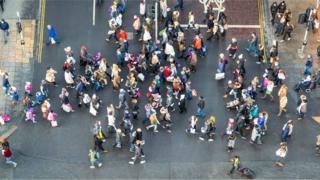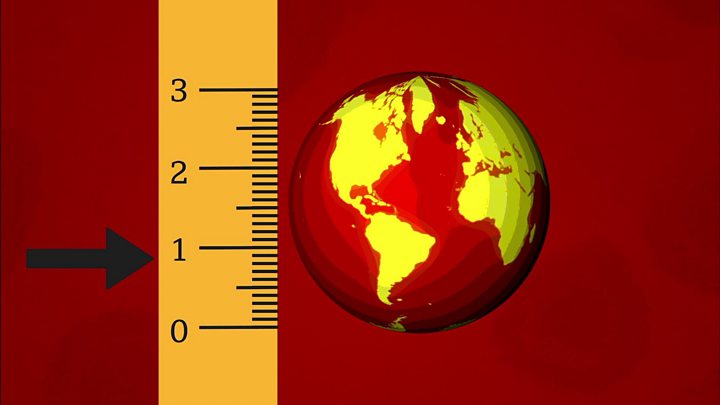
Image copyright
Getty Images
There have been warnings coronavirus may be starting to spread again in the north-west and the south-west of England.
Some scientists say the R number is creeping up across the country and may have surpassed one – the point at which the epidemic takes off again – in these regions.
Tameside Council has “strongly” advised schools not to reopen on Monday.
The government insists the number is not above one anywhere in the country.
So, what is going on? How worried should we be? And what does it mean for lifting lockdown?
Quickly, what is the R number again?
It is the number of people each infected person, on average, passes the virus onto.
If the R is three, then 10 people would infect 30 others. But if R is 0.5, those 10 people would infect only five.
An R of one is the crucial threshold. Anything lower and an epidemic is in decline, but if it goes higher then cases increase exponentially.

Media playback is unsupported on your device
What are the scientists saying?
That R is increasing across England.
One team at Public Health England (PHE) and the University of Cambridge says this has been the clear pattern in their data since 11 May, when restrictions in England were eased.
Their findings suggest we’re now balanced on the edge of a knife.
“Both the north-west and south-west are just above one, but all regions are straddling one,” said Dr Paul Birrell, one of the researchers.
But this is just one mathematical model and there is huge uncertainty in the figures. The PHE data gives a figure between 0.72 and 1.2 for London.
The London School of Hygiene and Tropical Medicine agrees the south-west may be above one, but paints a more optimistic view of the rest of England and their R number for the north-west is just 0.8.
“Overall, I would say we see R creeping up,” Dr Sebastian Funk, from the London School, told the BBC.
They also say the R number is 0.8 in Wales, Scotland and Northern Ireland.
Is this a catastrophe for lifting lockdown?
It would be easy to say yes, but the reality is confusing and it is important to understand what is driving any changes in R.
“It’s complicated, the reasons are many and difficult to untangle,” Dr Funk told me.
The most straightforward explanation is that the virus is genuinely spreading more. As the PHE report says: “We believe that this is probably due to increasing mobility and mixing between households and in public and workplace settings.”
But due to a counter-intuitive quirk of maths, lockdown can be a success, cases fall and R still goes up.
If cases collapse in the community – which appears to be happening – but come down more slowly in care homes and hospitals – which we also think is happening – then these areas will drag the R number back up, even though the situation is improving.
And when you get to low levels of infection, all the estimates become more uncertain and that too can make R appear higher.
“It’s a weird thing about R, it tells you the rate of change, and once all the way down, you can’t have R at a low level,” said Dr Funk.
Why is the government saying R is below one everywhere?
There is no perfect way of measuring R.
The government takes advice from multiple modelling groups, including the two above, which all estimate the figure from different angles. Some give more positive, others more negative, views on R.
It is the job of Sage, the government’s group of science advisors, led by chief science advisor Sir Patrick Vallance, to come to an overall view.
The official position is the R for the whole of the UK is between 0.7 and 0.9. Sage sources say, in their view, there is no region that has an R above one but some areas are “very close”.
Sir Patrick has consistently and publicly warned there is little room for manoeuvre in easing lockdown as R is on the cusp of one.
How long would it take to know if R is above one?
John Edmunds, professor of infectious disease modelling at the London School of Hygiene & Tropical Medicine, says it could take some time to identify a rising R number.
He told BBC Radio 4’s Today programme on Saturday the delay is “really concerning”.
“Numbers are relatively small, our measures are quite crude, so it would take some time to detect an increase in say the reproduction number,” he said.
“There are still quite a few infections in the community. I’d prefer to see fewer infections in the community.
“One in 600 is still quite a high rate. So I think it would be safer if we drove that rate right down before we ease things too much.”
How important are these figures and how worried should we be?
The first point is the number of cases is vital too. A high R is more of a problem when there is a lot of virus around.
“R shouldn’t be taken in isolation about the current level of threat,” said Dr Birrell.
The south-west has always had relatively few cases – currently 778 infections a day, according to PHE. However, Dr Birrell says the north-west – 4,170 infections a day – is “more worrying”.

Media playback is unsupported on your device
Also, relaxing lockdown is putting pressure on the “R number” to increase. Some school children are back in the classroom, businesses are reopening and we can see more people while maintaining social distance.
The full effect of this is expected to be seen in the official data in the coming weeks.
Dr Funk said: “We’re pretty close to R equals one whichever way you look at it, we’re lifting restrictions and if we see a sustained R greater than one then we need to do something about it.
“A day above one doesn’t concern me, a couple of weeks does.”
The next stage of controlling coronavirus will depend on getting a detailed picture of what is happening up and down the country.
The plan is to use “local lockdowns” that target clusters of cases that may be linked to a business or a care home.
But this will require an even more precise picture of what is going on than in these models. PHE lumps the north-east and Yorkshire into one region. It is a tidy 190-mile drive from Sheffield to Berwick-upon-Tweed.
Follow James on Twitter
Read MoreFeedzy


